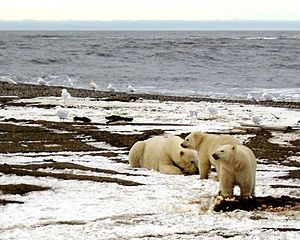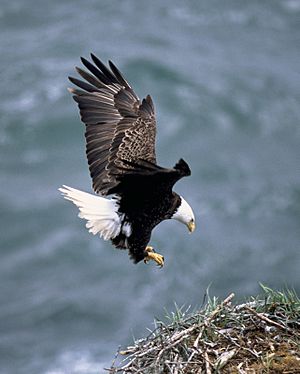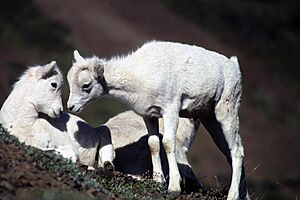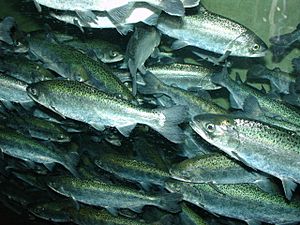Wildlife of Alaska facts for kids
Alaska is a giant state with an amazing variety of animals! Its wild lands, coasts, and waters are home to many different creatures. You can find everything from huge bears and moose to tiny frogs and colorful fish. Alaska is especially known for its large bear populations, including brown bears, grizzlies, black bears, and even polar bears. Many other mammals like caribou, wolves, and beavers also live here. The waters are full of fish like salmon and halibut, and hundreds of bird species soar through the skies. You might even spot sea lions, seals, and whales near the coast. Alaska's unique environment makes it a special place for wildlife.
Contents
Mammals
Brown bear

Alaska is home to most of the brown bears in the United States. About 30,000 brown bears live in Alaska. Their numbers are carefully managed by hunters each year.
Brown bears live almost everywhere in Alaska. You won't find them on some islands in the Aleutians or in the Bering Sea.
These bears are at the very top of the food chain in Alaska. How many bears live in one area depends on how much food is available. Some places, like McNeil River Falls, have a lot of brown bears.
Brown bears can be dangerous if you don't respect them. They are most risky when they have just caught food or when a mother bear has cubs. It's important to know how to stay safe in bear country.
Grizzly bears
Alaska also has most of the grizzly bears in North America. Grizzly bears are a type of brown bear found across North America.
Kodiak bears
Kodiak Island is home to the Kodiak bears. These are another type of brown bear. They are the largest brown bears in the whole world!
Black bear
The black bear is much smaller than the brown bear. They are common on the mainland of Alaska. However, you won't find them on islands off the Gulf of Alaska or the Seward Peninsula.
Black bears in Alaska come in many colors. They can be black, brown, cinnamon, or even a rare blue shade. They often come close to towns and camps because they are curious. They also look for easy food sources like garbage.
While black bear attacks are very rare, they can be a risk if they get used to human food. About 100,000 black bears live in Alaska.
Polar bear

Alaska's polar bears live along its cold Arctic coastlines. In winter, you can often see them in the Kuskokwim Delta and near St. Lawrence Island. During summer, they move to the coasts of the Arctic Ocean.
There are two main groups of polar bears in Alaska. The Chukchi group lives in western Alaska. The Beaufort Sea group is found near Alaska's North Slope.
For a long time, Inupiat hunted polar bears for food and supplies. Later, sport hunting also took place. Now, laws like the 1972 Marine Mammal Protection Act protect polar bears. Oil development and global warming might threaten polar bear populations. About 4,700 polar bears are known to live in Alaska.
Grizzly-polar bear hybrid
Sometimes, grizzly bears and polar bears have cubs together. These rare hybrid bears are often called pizzly or grolar bears. This happens more often now because the areas where grizzlies and polar bears live are starting to overlap.
Caribou

Alaska is home to a special type of caribou. While "caribou" and "reindeer" mean the same thing in other places, in Alaska, "reindeer" are only domesticated caribou. Wild caribou live in cold, treeless areas called tundra and in mountains. Many herds spend winter in the boreal forest.
Caribou travel long distances, sometimes up to 50 miles (80 km) in a single day! Their journeys depend on the weather and where they can find food. Changes in their migration can be a problem for Alaska Natives who rely on caribou for food.
There are many caribou in Alaska, about 950,000 of them. Their numbers are controlled by predators and by hunters. Even though there were worries about oil drilling harming caribou, they seem to have gotten used to humans.
Moose

The Alaskan moose is the largest type of moose in the world! Adult males can weigh up to 1,600 pounds (725 kg). Adult females weigh up to 1,300 pounds (591 kg).
Alaska has a lot of moose. Their numbers are controlled by predators like bears and wolves, who mostly hunt young calves. Hunters also take 6,000 to 8,000 moose each year.
Moose and humans often meet in Alaska. Moose have been important throughout the state's history. Athabascan people have hunted them for food, clothing, and tools. Today, you can often see moose eating along highways. Sometimes, they cause problems by eating crops or crossing roads. Moose are a very popular symbol of Alaska.
Mountain goat
Mountain goats live in the rough, rocky mountains of Alaska. You can find them in the southeastern Panhandle and along the Coast Mountains. They also live in the Chugach and Wrangell Mountains.
Mountain goats have been moved to Baranof and Kodiak islands, where they are doing well. These goats are the only goat-like animals in North America. They move between high mountain ridges in summer and lower, treed areas in winter.
Bison
The American bison in Alaska came from Montana in 1928. Twenty animals were brought and released near what is now Delta Junction. Other groups have grown along the Copper River and Chitina River. Some smaller, tamed groups also live near Kodiak.
Another type of bison, the wood bison, used to be very common in Alaska. They disappeared because of changes to their habitat and hunting. The last wood bison was seen in Alaska in the early 1900s. However, Alaska Native stories say these bison were a resource for people as recently as 200 years ago.
In 2003, there were about 900 wild American bison in Alaska. Their numbers are controlled by managed hunting. You can sometimes see bison from the Richardson Highway south of Delta Junction. The Alaska Department of Fish and Game is thinking about bringing wood bison back to Alaska from Canada.
Dall sheep
Dall sheep live, rest, and eat in the rocky, steep mountain areas of Alaska. They usually stay at high elevations. They only come down lower when food is hard to find. Their rocky home helps them avoid predators and people.
Alaska has a good number of Dall sheep. You can often see them in Denali National Park. Male Dall sheep are called "rams." You can tell them apart from females, called "ewes," by their thick, curling horns. The horns curl more as the ram gets older, reaching a full circle in seven to eight years.
Orca
The orca is also known as the killer whale. Even though they are called "killer whales," orcas are actually part of the dolphin family! They get their name because they hunt in large groups, much like wolves. They also eat other whales and large animals like seals and sea lions.
Orcas in Alaska are very big. Adult female orcas can grow up to 23 feet (7 meters) long. Adult male orcas can reach up to 27 feet (8.2 meters) long. You can find orcas along the coast from southeast Alaska through the Aleutian Islands. They are also seen in the waters of Prince William Sound.
Birds

Hundreds of bird species live in Alaska, especially along the coasts. Some of the notable birds in Alaska include:
Reptiles
Turtles
Alaska's waters are home to two kinds of turtles: the leatherback sea turtle and the green sea turtle.
Leatherback sea turtle
Leatherback sea turtles often live in the open ocean. But you might see them near the coast because they travel more than any other sea turtle. They are the biggest turtles in the world! They can weigh up to 2,000 pounds (907 kg) and grow to 6.5 feet (2 meters) long.
Their shell is not hard like other turtles. It's soft and leathery, about 1.5 inches (3.8 cm) thick. Their front flippers are also different. They don't have scales or claws, and they are much longer than other sea turtles' flippers.
Green sea turtle
The green sea turtle gets its name from its green skin, not its shell. Its shell is usually brown or dark olive. These turtles can weigh up to 700 pounds (317 kg) and grow up to 5 feet (1.5 meters) long. Most of them live in coastal waters near Europe and North America.
Male green sea turtles are larger than females and have longer tails. Both male and female turtles have paddle-shaped flippers. They use these flippers to dig in the sand and lay their eggs. A single green sea turtle can lay up to 200 eggs!
Amphibians
Frogs
Alaska has two native species of frogs: the Columbia spotted frog and the wood frog. Two other frog species have been brought to Alaska: the Pacific tree frog (also called the Pacific chorus frog) and the red-legged frog. The only type of toad in Alaska is the western toad.
Pacific chorus frog
The Pacific chorus frog is named for its loud mating call. The male frog makes a two-note sound by inflating two large, round sacs under its chin. This sounds like a chorus! These frogs are about 2 inches (5 cm) long. They have a black stripe from their nose to their shoulder. Their color can change with temperature and humidity.
Red-legged tree frog
The red-legged tree frog can grow over 5 inches (12.7 cm) long. It has long hind legs and a long body. Its body is a see-through red color. These frogs live in wet places like wetlands and moist forests. They usually lay their eggs in shaded streams and rivers.
Columbia spotted frog
The Columbia spotted frog is usually dark brown, gray, or green. It has spots on its back and sides. It lives in water environments like lakes, rivers, ponds, and marshes. They typically lay 200 to 500 eggs at a time in watery areas.
Wood frog
The wood frog is a light brown frog with dark patches over its eyes and down its back. These palm-sized frogs usually grow up to 3 inches (7.6 cm). The wood frog is known for its loud, harsh calls in spring to attract other frogs. It gets its name because it lives in heavily forested areas with rocks and trees. However, it lays its eggs in wetlands and can lay up to 3,000 eggs at once!
Western toad
The western toad is a large toad. It has small, round or oval-shaped bumps, called warts, down its back. This toad is often green or brown. It has dark glands above its eyes. The western toad has horizontal eyes, unlike other toads that have vertical pupils. Western toads live in low, wet areas like wetlands, lake shores, and marshes.
Salamanders
Alaska is also home to three types of salamanders: the northwestern salamander, long-toed salamander, and rough-skinned newt.
Northwestern salamander
The northwestern salamander is a dark brown salamander. It can grow up to 9 inches (23 cm) long. It has dark, bulging eyes and glands behind its eyes. This salamander can be poisonous to animals that try to eat it. It releases a white poison from its glands when it feels threatened. The northwestern salamander lives in both forests and water. It likes to live in burrows in the forest or under rocks and trees.
Long-toed salamander
The long-toed salamander lives in many different places, including coastal areas of the Pacific Northwest. You can find them in dry areas with sagebrush, in pine forests, and in mountain meadows. Their eggs and young have been seen in lakes, ponds, and even puddles. An adult salamander can grow between 2 and 3.2 inches (5 to 8.1 cm) long. They are usually black with colorful stripes on their back and white spots on their sides. This salamander has a long toe on its back foot, which is how it got its name!
Rough-skinned newt
The rough-skinned newt is a type of salamander. It has many colors, usually light brown on its back and yellow on its belly. Sometimes it can be olive green on its back. The rough-skinned newt can grow up to 10.2 inches (26.1 cm) long. It usually reaches at least 5 inches (12.7 cm). Its name comes from its bumpy, rough skin. The newt's skin is poisonous. It releases a strong poison called Tetrodotoxin that can affect nerves and skin.
Fish
Alaska has many different kinds of fish. Its lakes, rivers, and oceans are home to fish like trout, salmon, char, grayling, halibut, lampreys, lingcod, longnose sucker, pacific herring, black rockfish, salmon shark, sculpin, walleye pollock, white sturgeon, and various types of whitefish.
Salmon
Alaska has five types of salmon:
- The chum salmon is banded green, yellow, and purple with a white tip on its fin.
- The sockeye salmon is deep red with a white mouth.
- The coho salmon is maroon with black spots.
- The Chinook salmon, also called the "king salmon," has a black gum line and black mouth.
- The pink salmon is small and has an overall pink color.
Every year, salmon make a huge journey called the spawning migration. They swim upstream against the river currents in large numbers. You often see them jumping out of the water as they try to swim against the strong flow. Bears, especially brown bears, gather at the rivers to feast on the salmon during this time. Bear Lake near Seward has been a place where people help salmon populations grow since 1962.
Rainbow trout
The most common types of rainbow trout in Alaska are those that live in streams and the steelhead. Rainbow trout spend most of their lives in freshwater. When they grow up, they move into coastal areas where fresh and saltwater mix. The largest rainbow trout ever caught weighed almost 15 pounds (6.8 kg) and was 19 inches (48 cm) long. Rainbow trout live in streams and are native to the North Pacific Ocean.
Char
Arctic char in Alaska are closely related to both trout and salmon. However, they are tougher and can live in colder, deeper northern waters. The Arctic char can weigh up to 20 pounds (9 kg).
Grayling
The grayling lives in mountain lakes and calm rivers. The grayling has a long fin on its back that is multicolored, often with reds and blues.
Halibut
The Pacific halibut is the largest flatfish in its family. Halibut swim sideways because their bodies are flat. Most adult halibut have both eyes on their upward-facing side. Their scales are hidden in their skin, making them look smooth.
Lamprey
The lamprey is an eel-like fish without jaws. It is part of the Petromyzonidae family. Lampreys are freshwater fish often found near coastal waters. Their young live buried in these waters.
Lingcod
The lingcod is a fish that eats food from the bottom of the ocean. They are caught for food. It is a large fish that can grow up to 5 feet (1.5 meters) long and weigh up to 80 pounds (36 kg) when fully grown. Their colors range from brown, gray, green, blue, and pink. They have dark and light spots. Lingcod live deep on the ocean floor and are found in coastal areas around Alaska and in the Bering Strait.
Longnose sucker
The longnose sucker is the most widespread sucker fish in Alaska. It can weigh up to 5 pounds (2.3 kg) and lives in cold water streams. The sides, head, and top of the longnose sucker are dark green to slate black, while its belly is often white or yellow.
Pacific herring
The Pacific herring does not have any special markings. It is sleek and silver with a bluish-green tint. The scales on its underside create a slightly jagged edge. The Pacific herring can grow up to 18 inches (45 cm), but they rarely grow past 9 inches (23 cm).
Black rockfish
The black rockfish is a grayish-black fish with a large mouth. It has a spiny fin on its back and dark stripes from its eyes to its gills. This fish can weigh up to 11 pounds (5 kg) and grow up to 27.6 inches (70 cm) when it reaches adulthood.
Salmon shark
The salmon shark is a shark that can grow up to 10 feet (3 meters) long. This shark is light gray with a white tail. Male salmon sharks become adults between 9–10 years old, while female sharks mature around 10–11 years old.
Sculpin
Sculpin are small fish that live in fresh or saltwater. They rarely grow longer than 7 inches (17.8 cm). Their homes range from small streams to slow, rocky streams and coastal saltwater areas. Sculpin are flat and have wide fins. These fins help them hold onto the bottom of the water in strong currents.
Walleye pollock
The walleye pollock is a very important fish for Alaska's fishing industry. The pollock is a type of cod. It has many colors, including brown, green, silver, and white. The walleye pollock can grow up to 3.5 feet (1 meter) long and weigh up to 13.3 pounds (6 kg). It is sometimes called the "fake Walleye."
White sturgeon
The white sturgeon is different from other fish because it doesn't have scales. Instead, it has bony plates called scutes that run from its gills to its tail. The white sturgeon is a bottom-feeder, meaning it searches the sea floor for food. This fish has no teeth and sucks in its food. It also has tastebuds on the outside of its mouth!
Marine macroinvertebrates
Alaska's ocean waters are home to over 3,700 recorded species of marine macroinvertebrates. These are animals without backbones that live in the ocean. They live from the shallow intertidal zone to the deep abyssal depths. You can find them from the Arctic border with Canada all the way to the southern border with British Columbia. Some of the most common ones you might see are different kinds of shrimp, crab, lobster, and sponge.
Endangered species
Alaska has one of the shortest lists of endangered species in the U.S. According to the Alaska Department of Fish & Game, there are only 12 endangered species, and almost all of them live in the ocean. They are:
Extinct species
Several local species have disappeared since Europeans arrived in the region. They include:
- Steller's sea cow
- Spectacled cormorant





